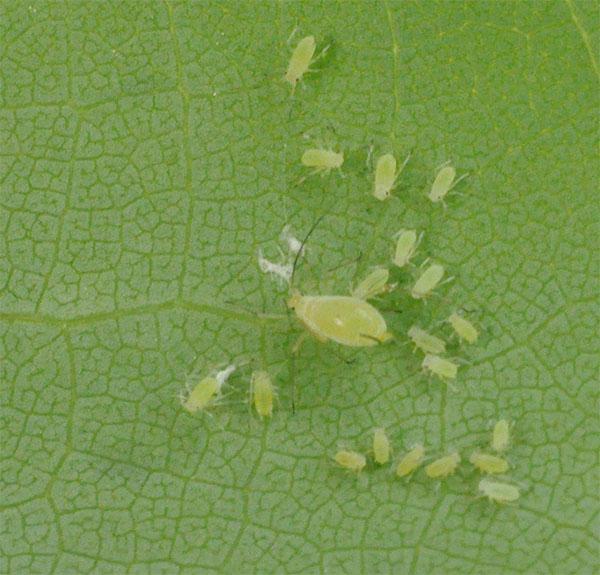A Good Spring for Aphids
By Lee Townsend
Aphids are among the first insects to appear on trees in the spring. They thrive under cool, rainy, conditions; our weather pattern to date has favored them.
Aphids occur in colonies on tender growth: flower buds, expanding leaves, and/or growing stems. These soft-bodied insects use their thin, piercing sucking mouthparts to feed on plant sap. Salivary secretions help them pre-digest plant sap. Effects differ. The saliva may cause infested leaves to turn yellow, wilt, become distorted, stunted, or develop growths called galls. This varies depending upon the tree, aphid species, and their numbers.
Rich plant sap is filtered in the aphids’ digestive tract to remove nutrients. However, aphids cannot efficiently process the large volumes that they ingest so they excrete water still containing nutrients. This sugary waste liquid (honeydew) forms sticky residues where it lands. The deposits support the growth of fuzzy, dark, sooty mold, as well as, attracting ants, bees, and other insects.
 Early detection is the key to reducing potentially damaging aphid infestations. Weekly examination during the spring will help to determine the need for management. Examine tender growth and the undersides of newly expanded leaves for aphid colonies.
Early detection is the key to reducing potentially damaging aphid infestations. Weekly examination during the spring will help to determine the need for management. Examine tender growth and the undersides of newly expanded leaves for aphid colonies.
Individual aphid colonies on small trees can be crushed by hand or infested leaves can be removed as they are found. In some cases, this may provide adequate control. A strong jet of water can knock off many aphids, few of them are likely to survive and return. If lady beetles or other aphid predators are present, give them a chance to provide some natural control.
If there are aphid colonies on 10% or more of foliage or growing tips of already stressed plants, then a different type of control measure may be justified. There are several insecticide alternatives. Most work by contact so the aphids must be hit directly with spray droplets. Direct sprays to the undersides of leaves and other infested surfaces.
Insecticidal soaps or summer horticultural oils can provide contact control. They are contact sprays that do not have residual effects so they are less likely to harm beneficial insects or to result in outbreaks of mites later in the season. Check the label for cautions on sensitive plants; oils can injure the foliage of some plants. Weather conditions, especially high temperatures, can increase the potential for foliage burn. There is no residual effect so evaluate success of control by looking for live aphids 3 to 5 days after treatment. Additional applications may be necessary.
It is difficult or impractical to treat large trees because of the high spray pressure necessary to penetrate the foliage and to reach the tallest portions of the tree. However, they are much less likely to be harmed by aphid infestations.
In most cases, infestations will disappear as aphids leave trees in late spring and migrate to a different host plant for the summer. Watch for them again in the fall.
Photography
- Aphid colony; a large female with her offspring (Lee Townsend)
About the Author
Dr. Lee Townsend is an Extension Entomologist in the University of Kentucky College of Agriculture. Email @ Lee.Townsend@uky.edu
